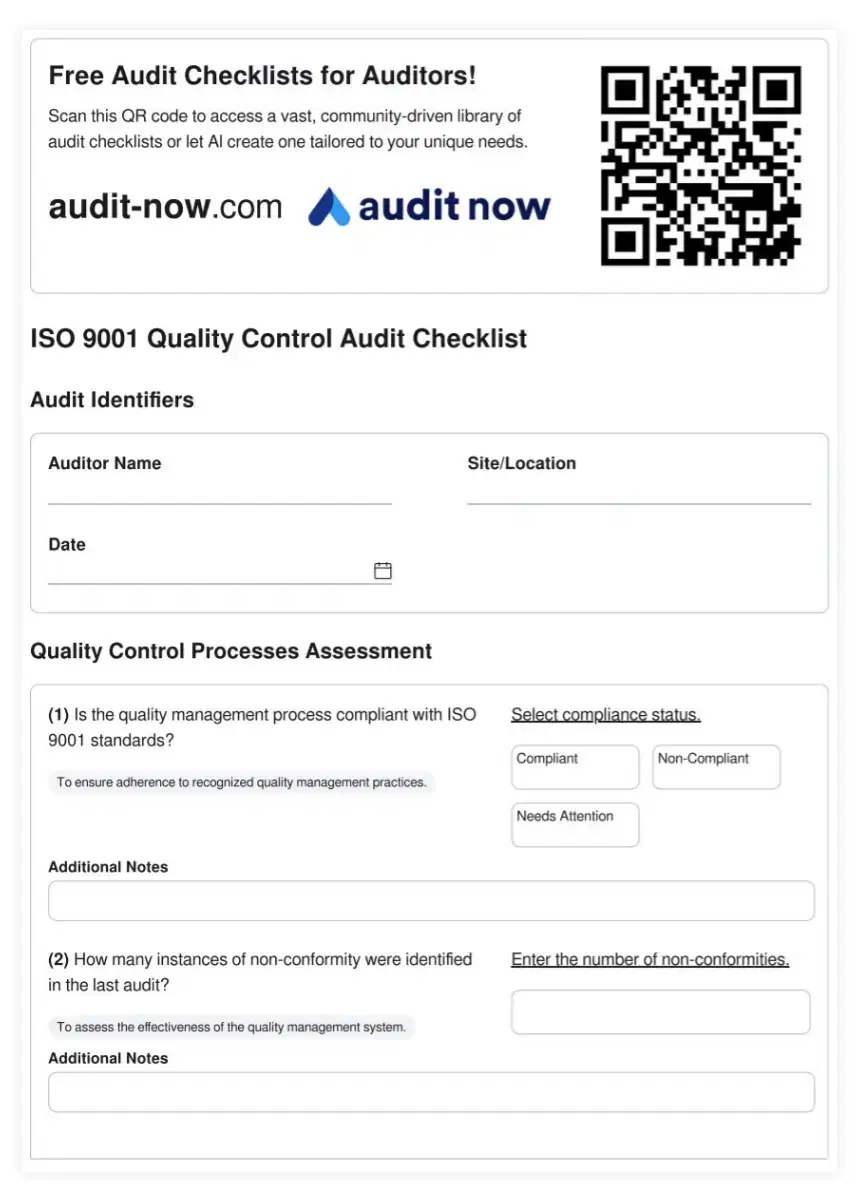Aircraft Maintenance Facility: Ensuring Safety and Efficiency in Aviation

Featured Checklist

Aircraft Maintenance Program Compliance Checklist
The Aircraft Maintenance Program Compliance Checklist is an indispensable tool for aviation maintenance professionals ensuring adherence to EASA regulations across various aircraft categories. This comprehensive checklist streamlines the process of verifying that maintenance programs align with the requirements set forth in EASA CS-23, CS-25, CS-27, and CS-29 specifications. By systematically evaluating maintenance intervals, tasks, and procedures, this checklist helps maintain airworthiness, enhance safety, and optimize aircraft performance while ensuring regulatory compliance.
Understanding Aircraft Maintenance Facilities
Aircraft maintenance facilities are specialized workspaces dedicated to keeping aircraft safe, reliable, and airworthy. These facilities play a crucial role in the aviation industry, performing routine checks, repairs, and overhauls on various types of aircraft. From small private planes to large commercial airliners, maintenance facilities ensure that every aircraft meets strict safety standards and regulatory requirements.
Maintenance facilities are equipped with advanced tools, diagnostic equipment, and skilled technicians who work tirelessly to keep aircraft in optimal condition. These spaces are designed to accommodate different types of maintenance activities, from minor inspections to major overhauls, and must adhere to stringent safety and quality control measures.
Key Components of an Aircraft Maintenance Facility
An effective aircraft maintenance facility comprises several essential components:
- Hangar space: Large, climate-controlled areas to house aircraft during maintenance
- Specialized tools and equipment: Including lifts, jacks, and diagnostic tools
- Parts inventory: A well-stocked supply of approved aircraft components
- Maintenance documentation: Up-to-date technical manuals and service bulletins
- Skilled workforce: Certified technicians and engineers with expertise in various aircraft systems
- Quality control systems: Processes to ensure all work meets required standards
- Safety equipment: Fire suppression systems, personal protective gear, and emergency response tools
Core Audit Requirements for Aircraft Maintenance Facilities
Auditing is a critical process in aircraft maintenance facilities to ensure compliance with regulations and maintain high safety standards. Some key audit requirements include:
Regulatory Compliance
Maintenance facilities must adhere to regulations set by aviation authorities such as the Federal Aviation Administration (FAA) or the European Union Aviation Safety Agency (EASA). Audits verify compliance with these regulations, including proper documentation, adherence to maintenance procedures, and personnel qualifications.
Quality Management System
A robust quality management system is essential for maintaining consistency and reliability in maintenance operations. Audits assess the effectiveness of quality control processes, documentation practices, and continuous improvement initiatives.
Safety Management
Safety is paramount in aircraft maintenance. Audits evaluate safety protocols, risk assessment procedures, and the implementation of safety management systems to prevent accidents and ensure a safe working environment.
Tool and Equipment Calibration
Regular calibration of tools and equipment is crucial for accurate maintenance work. Audits check calibration records, procedures, and the traceability of measuring instruments used in maintenance tasks.
Personnel Training and Certification
Maintenance staff must be properly trained and certified. Audits review training records, certification validity, and ongoing professional development programs to ensure technicians are qualified for their roles.
Boost Your Compliance Today
Don’t wait—start facilitating your audits and inspections now!
Try now!
Importance of Checklists for Operational Excellence
Checklists play a vital role in achieving operational excellence in aircraft maintenance facilities. They provide a systematic approach to complex tasks, reducing the risk of human error and ensuring consistency in maintenance procedures. Key benefits of using checklists include:
1. Standardization of processes across different shifts and personnel
2. Reduction of oversight and omissions in critical maintenance tasks
3. Enhanced compliance with regulatory requirements and industry standards
4. Improved efficiency and productivity in maintenance operations
5. Facilitation of training and knowledge transfer among staff members
Best Practices for Aircraft Maintenance Facility Audits
To conduct effective audits in aircraft maintenance facilities, consider the following best practices:
Comprehensive Planning
Develop a detailed audit plan that covers all aspects of the maintenance facility, including documentation, processes, equipment, and personnel. This ensures a thorough evaluation of the facility's operations.
Use of Digital Tools
Implement digital audit tools to streamline the audit process, improve data collection, and facilitate real-time reporting. Digital solutions can enhance the accuracy and efficiency of audits.
Regular Schedule
Establish a regular audit schedule to maintain ongoing compliance and identify areas for improvement. Consistent auditing helps prevent issues from escalating and ensures continuous adherence to standards.
Cross-functional Teams
Involve auditors from different departments or external experts to gain diverse perspectives and expertise during the audit process. This approach can uncover blind spots and provide valuable insights.
Follow-up and Corrective Actions
Implement a robust system for tracking audit findings, implementing corrective actions, and following up on improvements. This ensures that identified issues are addressed promptly and effectively.
Streamline Your Aircraft Maintenance Facility Audits with Audit Now
Audit Now offers a comprehensive digital solution tailored to the operational excellence and auditing needs of aircraft maintenance facilities. Our platform features AI-powered checklists, real-time collaboration tools, and automated reporting to streamline your entire audit process while maintaining the highest standards of accuracy and compliance.
To get started with Audit Now:
1. Visit our website at audit-now.com
2. Explore our extensive template library at https://audit-now.com/templates/
3. Try our AI-powered checklist generator at https://audit-now.com/generate-ai-checklist/
4. Sign up for a free trial to experience the full capabilities of our platform
With Audit Now, you can transform your aircraft maintenance facility audits, ensuring safety, compliance, and operational excellence in your aviation operations.